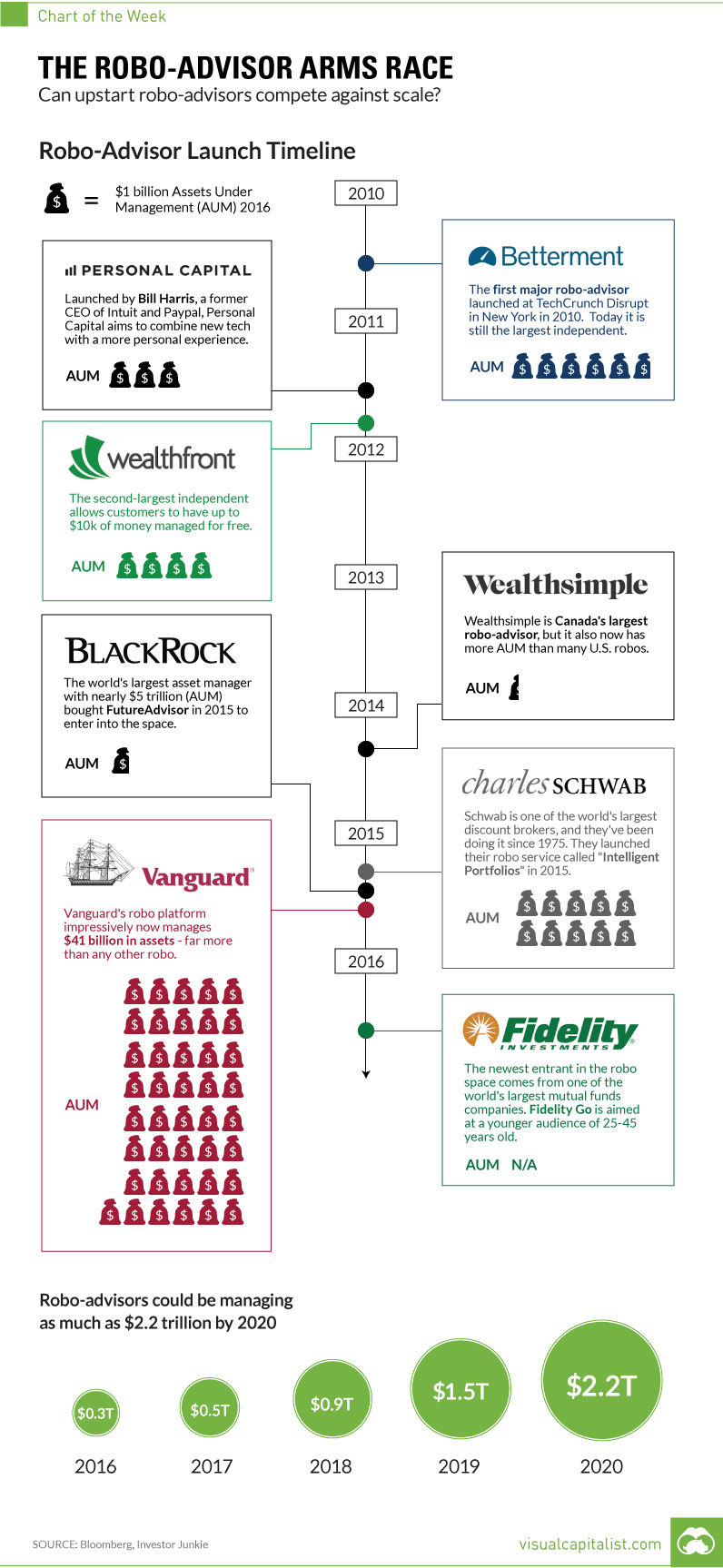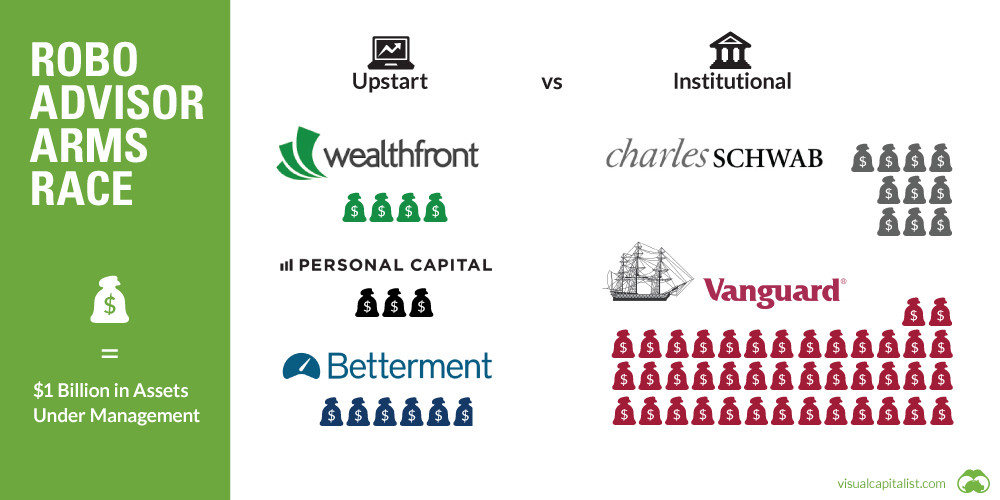Technology
Chart: The Robo-Advisor Arms Race

The Robo-Advisor Arms Race
Can upstart robo-advisors compete against scale?
The Chart of the Week is a weekly Visual Capitalist feature on Fridays.
It was going to happen sooner or later.
When they launched roughly five years ago, tech-driven companies such as Betterment or Wealthfront had the audacious and laudable goal of taking on the incumbents of the gargantuan wealth management industry. Many traditional wealth managers were skeptical of portfolios being driven by artificial intelligence, and adopted a “wait and see” approach. If it became clear that the machines were indeed taking over the wealth management industry, they could then find some way to reverse-engineer their way into the market, using their scale and connections to make up ground.
As the upstarts won new accounts and proved out the robo-advisor business model, the incumbents that dominate the traditional finance scene leaped into action. In 2015, behemoths like Vanguard and Charles Schwab, which each manage trillions of dollars of assets, fought back by introducing their own robo-advisor products. Meanwhile, Blackrock made an acquisition of an existing platform (FutureAdvisor) to enter the market, and just months ago mutual fund giant Fidelity launched its own robo-product called Fidelity Go.
The scale of these companies meant that domination would become inevitable. Vanguard, for example, took its Personal Advisor Services platform from $0 in assets under management (AUM) last year to $41 billion today. By our math, that’s more than all other major U.S. robo-advisors combined.
Charles Schwab, which has 9.3 million existing customers for its discount brokerage services, had no problem bringing customers over to its new platform. It also has $10 billion in AUM already in just a year, which is more than Betterment and Wealthfront combined.
Spokespeople for the independent robo-advisors will tell you that they are building products for millennials, with an eye on a bigger prize. As wealth is transferred to the millennial generation over the coming years, they will be in position to take advantage of this as the brands that millennials trust. We are certain that these startups can evolve into great companies with this mission, but we also wonder if they ultimately left money on the table.
Were they not aggressive enough? Could they have partnered with a bigger institution to roll out their product faster? Could they have gotten a bigger piece of the pie?
It’s hard to say, but the robo-advisor space continues to be an interesting one to watch. It also teaches us an interesting lesson about trying to compete with mega-sized companies, which have scale, expertise, and resources at their disposal.
Technology
Visualizing AI Patents by Country
See which countries have been granted the most AI patents each year, from 2012 to 2022.

Visualizing AI Patents by Country
This was originally posted on our Voronoi app. Download the app for free on iOS or Android and discover incredible data-driven charts from a variety of trusted sources.
This infographic shows the number of AI-related patents granted each year from 2010 to 2022 (latest data available). These figures come from the Center for Security and Emerging Technology (CSET), accessed via Stanford University’s 2024 AI Index Report.
From this data, we can see that China first overtook the U.S. in 2013. Since then, the country has seen enormous growth in the number of AI patents granted each year.
| Year | China | EU and UK | U.S. | RoW | Global Total |
|---|---|---|---|---|---|
| 2010 | 307 | 137 | 984 | 571 | 1,999 |
| 2011 | 516 | 129 | 980 | 581 | 2,206 |
| 2012 | 926 | 112 | 950 | 660 | 2,648 |
| 2013 | 1,035 | 91 | 970 | 627 | 2,723 |
| 2014 | 1,278 | 97 | 1,078 | 667 | 3,120 |
| 2015 | 1,721 | 110 | 1,135 | 539 | 3,505 |
| 2016 | 1,621 | 128 | 1,298 | 714 | 3,761 |
| 2017 | 2,428 | 144 | 1,489 | 1,075 | 5,136 |
| 2018 | 4,741 | 155 | 1,674 | 1,574 | 8,144 |
| 2019 | 9,530 | 322 | 3,211 | 2,720 | 15,783 |
| 2020 | 13,071 | 406 | 5,441 | 4,455 | 23,373 |
| 2021 | 21,907 | 623 | 8,219 | 7,519 | 38,268 |
| 2022 | 35,315 | 1,173 | 12,077 | 13,699 | 62,264 |
In 2022, China was granted more patents than every other country combined.
While this suggests that the country is very active in researching the field of artificial intelligence, it doesn’t necessarily mean that China is the farthest in terms of capability.
Key Facts About AI Patents
According to CSET, AI patents relate to mathematical relationships and algorithms, which are considered abstract ideas under patent law. They can also have different meaning, depending on where they are filed.
In the U.S., AI patenting is concentrated amongst large companies including IBM, Microsoft, and Google. On the other hand, AI patenting in China is more distributed across government organizations, universities, and tech firms (e.g. Tencent).
In terms of focus area, China’s patents are typically related to computer vision, a field of AI that enables computers and systems to interpret visual data and inputs. Meanwhile America’s efforts are more evenly distributed across research fields.
Learn More About AI From Visual Capitalist
If you want to see more data visualizations on artificial intelligence, check out this graphic that shows which job departments will be impacted by AI the most.
-

 Mining1 week ago
Mining1 week agoGold vs. S&P 500: Which Has Grown More Over Five Years?
-

 Markets2 weeks ago
Markets2 weeks agoRanked: The Most Valuable Housing Markets in America
-

 Money2 weeks ago
Money2 weeks agoWhich States Have the Highest Minimum Wage in America?
-

 AI2 weeks ago
AI2 weeks agoRanked: Semiconductor Companies by Industry Revenue Share
-

 Markets2 weeks ago
Markets2 weeks agoRanked: The World’s Top Flight Routes, by Revenue
-

 Countries2 weeks ago
Countries2 weeks agoPopulation Projections: The World’s 6 Largest Countries in 2075
-

 Markets2 weeks ago
Markets2 weeks agoThe Top 10 States by Real GDP Growth in 2023
-

 Demographics2 weeks ago
Demographics2 weeks agoThe Smallest Gender Wage Gaps in OECD Countries












